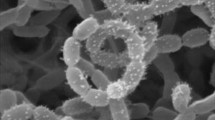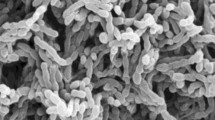Summary
A new gram-positive filamentous bacterium with coccoid cells has been isolated from bulking sludge from five sewage treatment plants in West-Germany. The characteristics of five strains are described. Their fatty acids and cell wall composition are similar to the Streptococcaceae and they mainly degrade monomeric and dimeric carbon sources. They are classified as a new genus and species of the family Streptococcaceae: Trichococcus flocculiformis gen. nov. sp. nov.
Similar content being viewed by others
References
Brock TD (1964) Knots in Leucothrix mucor. Science 144:870–871
Buchanan RE, Gibbons NE (eds) (1975) Bergey's manual of determinative bacteriology, 8th edn. The Williams and Wilkins Co., Baltimore
Conn HJ, Jennison MW, Weeks OB (1957) Routine tests for the identification of bacteria. In: Society of American Microbiologists (eds) Manual of microbiological methods. McGraw-Hill Book Co., Inc., New York Toronto London, pp 140–168
Cummins CS, Johnson JL (1971) Taxonomy of the Clostridia: Wall composition and DNA homologies in Clostridium butyricum and other butyric acid-producing Clostridia. J Gen Microbiol 67:33–46
Cyrus Z, Sladká A (1970) Several interesting organisms present in activated sludge. Hydrobiologia 35:383–396
Eikelboom DH (1975) Filamentous organisms observed in activated sludge. Wat Res 9:365–388
Eikelboom DH (1980) Fadenförmiger Blähschlamm — Ein von einer Gruppe praktisch unbekannter Mikroorganismen verursachtes Problem. Forum Mikrobiologie 3:21–23
Farquhar GJ, Boyle WC (1971a) Identification of filamentous micro-organisms in activated sludge. J Water Pollut Control Fed 43:604–622
Farquhar GJ, Boyle WC (1971b) Occurrence of filamentous micro-organisms in activated sludge. J Water Pollut Control Fed 43:779–798
Grimont PAD, Grimont F, Dulong de Rosnay HLC (1977) Taxonomy of the genus Serratia. J Gen Microbiol 98:39–66
Harper JJ, Davis GHG (1979) Two-dimensional thin-layer chromatography for amino acid analysis of bacterial cell walls. Int J Syst Bacteriol 29:56–58
Kroppenstedt R (1982) Anwendung von Dünnschicht- und Gas-Chromatographie in der Bakterientaxonomie. Chromatographie (Suppl):34–40
Lewis BA, Smith F (1967) X. Zucker und Derivate. In: Stahl E (Hrsg) Dünnschichtchromatographie. Springer, Berlin Heidelberg New York, S 769–798
Mandel M, Schildkraut CL, Marmur J (1968) Use of CsCl density gradient analysis for determining the guanine plus cytosine content of DNA. In: Grossmann L, Moldave K (eds) Methods in enzymology, vol XII B. Academic Press, New York London, pp 184–195
Marmur J (1961) A procedure for the isolation of deoxyribonucleic acid from micro-organisms. J Mol Biol 3:208–218
Marr AG, Ingraham JL (1962) Effect of temperature on the composition of fatty acids in Escherichia coli. J Bacteriol 84:1260–1267
Reynolds ES (1963) The use of lead citrate at high pH as an electron-opaque stain in electron microscopy. J Cell Biol 17:208–212
Ruchhoft CC, Watkins JH (1928) Bacteriological investigation and study of filamentous organisms in the activated sludge of the Des Plaines river sewage treatment works. Sewage Wks J 1:52–58
Salcher O, Scheff G, Senghas E, Trick I, Lingens F (1982) The nutritional pattern of filamentous bacteria isolated from bulking sludge. Zentralbl Bakteriol Hyg [Orig C] 3:450–456
Schleifer KH, Kandler O (1967) Zur chemischen Zusammensetzung der Zellwand der Streptokokken. I. Die Aminosäuresequenz des Mureins von Str. thermophilus und Str. faecalis. Arch Microbiol 57:335–364
Schleifer KH, Kandler O (1972) Peptidoglycan types of bacterial cell walls and their taxonomic implications. Bacteriol Rev 36:407–477
Shaw N (1974) Lipid composition as a guide to the classification of bacteria. Adv Appl Microbiol 17:63–108
Skerman VBD (1967) A guide to the identification of the genera of bacteria, 2nd edn. Williams and Wilkins Co., Baltimore
Spurr AR (1969) A low-viscosity epoxy resin embedding medium for electron microscopy. J Ultrastruct Res 26:31–43
Van Veen WL (1973) Bacteriology of activated sludge, in particular the filamentous bacteria. Antonie van Leeuwenhoek. J Microbiol Serol 39:189–205
Author information
Authors and Affiliations
Rights and permissions
About this article
Cite this article
Scheff, G., Salcher, O. & Lingens, F. Trichococcus flocculiformis gen. nov. sp. nov. A new gram-positive filamentous bacterium isolated from bulking sludge. Appl Microbiol Biotechnol 19, 114–119 (1984). https://doi.org/10.1007/BF00302451
Received:
Issue Date:
DOI: https://doi.org/10.1007/BF00302451




